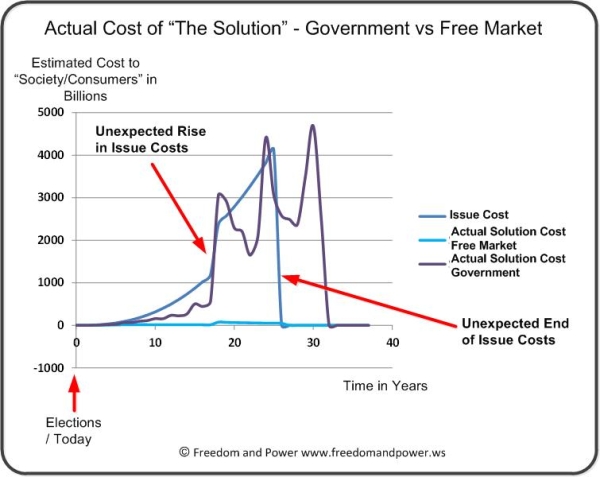 LET'S COMPARE
LET'S COMPARE
Up to this point we have explained what happens with a government solution and with a Free Market one. Now, let's put them together in the same graph as we did before and let's compare.
(See the first graph below)
And just because we are evil, we will rub it in by adding a second axis as we did before and remove the Issue Cost for better visibility. When we do so we get:
(See the second graph below)
The Comparison
And now that we can see what is what, we can reach a few conclusions summarized in the table below:
|
Issue (Topic) |
Government Response |
Free Market Response |
|
Planning |
Plans for the long term taking assumptions as immutable. |
Plans for the short-to-medium term recognizing that assumptions will change. |
|
Cost estimates |
Generates reasonable estimates. |
Generates reasonable estimates but up to the planning horizon only. |
|
Actual costs |
Requires massive overspendings which are mind-blowingly higher than estimates. |
Delivers in or about estimates. |
|
Over time |
Costs grow over time because of government inefficiencies. |
Costs decrease over time because of free market incremental efficiencies. |
|
Unexpected cost increases or issue impacts |
Overspendings go through the roof simultaneously becoming highly unstable with wild oscillations. |
Costs are adjusted upwards but always in-line with the previously used estimation methodology. |
|
Sudden end to the Issue |
Spending continues for a long time wasting massive amount of resources. |
Spending is cut almost instantaneously to prevent losses. |


BACK TO THE BEGINNING OR JUST-IN-TIME
Now that we have spent a few days showing you how the whole thing operates, we can finally! go back to the topic of this article… and we do appreciate your patience.
One of the most annoying barriers to Libertarianism and Austrian Economics is the fact that people are governed by the principle of Time Preference. Because of this principle, we want solutions now and not later. This is typically exemplified in the fact that saving for the future is quite difficult as we prefer to spend now and not in a distant future.
In the same manner, this type of preference spills over onto the perceptions that people have of government actions. As such, when a government proposes to "do something" about this "pressing issue"; we enjoy such "action" because it is being delivered now as opposed to in the future. Again, we want the plan now; we want certainty now and not later on.
With this pre-disposition built into our genetic makeup, we have severe difficulties in looking at what the Free Market is doing and agree with it or like it. Allow us to explain.
The Free Market does not identify an "issue" until it is actually a problem. It does so for a very good reason, and this reason is that there is no market for it. Any solution that may be developed before that point in time won't have customers. People are simply not interested in such solutions that solve nothing. Governments, on the other hand, don't care about this "detail" because it is not their money, it is yours! And they can always squeeze more out of you. Furthermore, people have thoroughly dissociated the notion that what a government spend comes out of their pockets. From the perspective of a regular person, a government is an independent entity capable of providing an infinite amount of wealth out of thin air. Thus, delivering "solutions" now to an "issue" which may or may not happen in the future is perfectly reasonable because it won't come out of people's pockets!
Sounds familiar?
In contraposition, Free Markets operate based on the principle of Just-In-Time and this runs contrary to the Time Preference principle. This is to because typically Just-In-Time means delaying the deliverance of the "solution" until there sufficient demand for it in order to sustain manufacturing. This means that many actual, real issues will go unanswered by the Free Market until a critical mass of potential customers becomes available.
Think of it this way.
We hate when our cat drinks water from her plate and spills it onto the floor. We would love to have a spill-proof, self-cleaning, self-renewing, solar-powered, water-hooked cat basin. Yet, it is very unlikely we will see such a product any time soon.
However, should "our representative" in the government would to identify this "issue" which "affect the lives of his/her cat-loving constituents or represented base" then "government action" is "merited" and as such it should be implemented immediately. Furthermore, plans must be drawn now to deliver the "solution" to all people for free and have plans for advanced models which will use cold fusion as a source of energy and obtain water directly from the humidity of its surroundings. In addition, such "solutions" shall be delivered to all who request them for free!
Now let's pause for a second and analyze this. The government will deliver a "solution" to our problem now and it will do so for free! What is not to like?
Furthermore, we don't have to wait until the Free Market solves our problem, if ever!
Of course, the real problem is that we can't see all the implications; we can't see all the costs; we can't see that it is our problem and not your problem; we can't see the negative economic impact of diverting that money from more productive endeavours and so on. All we can see is that our problem will be solved now!
Now let's assume that the Free Market will solve this problem. A suitable product will be developed. Problem is, it will be developed Just-In-Time. Just-In-Time for what? Just in time to support a sufficiently large consumer base to ensure the product will be profitable. And Just-In-Time usually does not mean now.
Note: please see the Glossary if you are unfamiliar with certain words.




